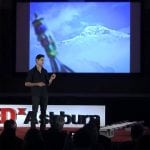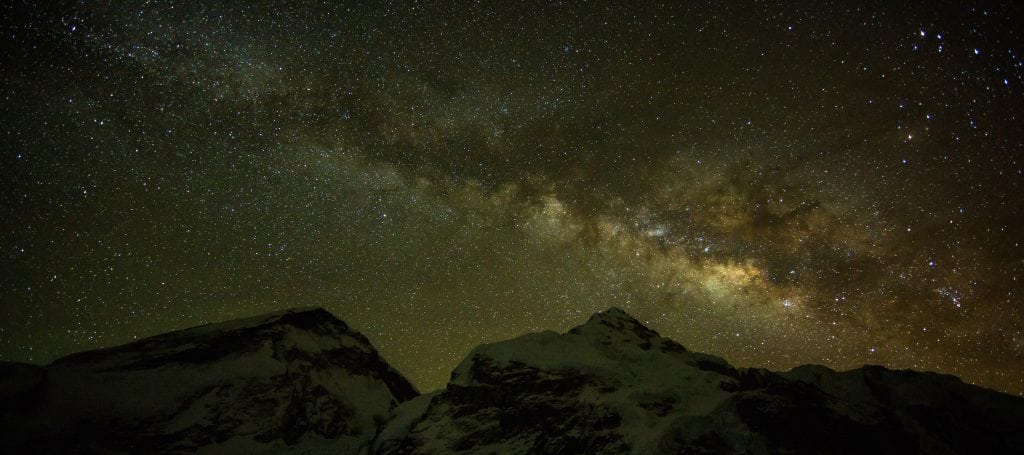It’s 9 p.m. on May 20th and we’ve been in the death zone for just over five hours.
Life is not meant to exist here.
In the death zone, we’re all transient beings. I lie in my sleeping bag with an oxygen mask strapped to my head, devouring each artificial breath of life as though it were my last.
Something is wrong. My heart is racing. My palms are sweating and I’m coughing up green phlegm uncontrollably.
Last night my oxygen mask failed at camp three and while all others slept with the gift of supplemental oxygen, I instead froze and drifted in and out of consciousness.
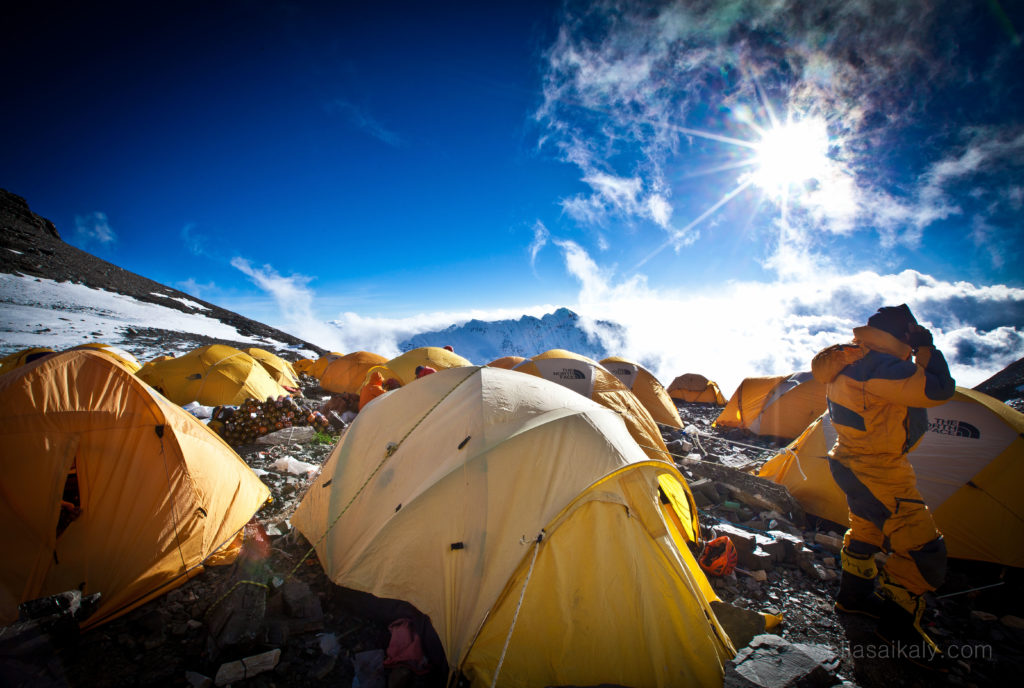
For the first time in my life I am terrified to fall asleep. I’m afraid because there’s a chance I’m not going to wake up. HAPE and HACE (high altitude pulmonary and cerebral edema) is the fatal high-altitude illness where the brain or lungs swell and fill with water, often followed by coma then death.
I know my body well and this is by far the worst I have ever felt. Weeks of operating at max capacity while shooting video for this reality TV series on Mt. Everest may have finally caught up with me.
My body is exhausted from running ahead of the group, trying to capture moments on screen, all without interrupting the flow of the expedition. It’s relatively easy to run ahead of a group while trekking at sea level with a camera, but it’s a whole other level wearing a down-suit, 8,000 metre boots, gloves and an oxygen mask while racing ahead of a group ascending the highest mountain on Earth.
It’s debilitating. In a world where the rule is to never exceed 60% of your capacity, I’m revving at 120% continuously for eight to 10 hours at a time.
When I close my eyes, I experience visions of crossing over to the other side. Magnetic waves are pulsing and pulling me deeper into my mind. There is a bright light ahead seducing me and attempting to convince me to surrender to the pull into the land of the ever-dormant. It’s beautiful, I whisper to myself. I open my eyes, sit up immediately and cough uncontrollably. This is not happening to me! I begin to consume copious amounts of water in an attempt to recover. I devour five energy gels, three packs of gummies, one and a half servings of high-altitude chicken curry and three frozen energy cookies.
Consuming calories and liquid combined with breathing supplemental oxygen at four litres per minute is my saving grace. At least, that’s what I tell myself. I trust I have done all I can and permit myself to fall asleep.
This is the most terrifying moment of my life.
With the sound of oxygen flowing through an artificial mask, I give in and drift away wondering whether or not I will ever wake up.
The sound of violent wind hammering at the thin nylon yellow walls of my North Face tent forces me awake. I’m alive! My super-hydration strategy seems to have worked and my choice not to alarm anyone with my condition has paid off. The guides have enough to worry about with our three-man team of Arab climbers. These boys are living their dream and I’m here to document the realization of that dream.
I will not be a liability. I’ve recorded their journeys to the summit of Mt. Elbrus and Mt. Aconcagua and now it’s time to accompany them to the summit of the tallest mountain on Earth. Time to flip the switch.
Like a warrior preparing for battle in the confines of my claustrophobic tent, I prepare dozens of batteries, clean all of my lenses and mentally walk through the next 24 hours in my mind. I envision the areas of the climb where I will use my tripod and my GoPros. I imagine the areas where I will switch my lenses and run ahead of the group to acquire the shots I’ve been dreaming of capturing for months. It’s all been premeditated at lower altitudes because there is always a chance that everything can go wrong, including the capacity for my brain to make irrational and illogical decisions.
As a climber, I plan for every scenario including failure. I mentally prepare for the most difficult day of my life. I will depart with deep awareness for the potential pain, while focusing on the incredible feat that I must undertake and the shots I want to capture along the way.
At 10 p.m. I’m standing in the death zone under the moonlit Himalayan sky. We’re seconds away from departure. In one hand I hold my Canon T3i, a lighter choice for the evening portion of the climb, and in my left is a portable LED light that illuminates the faces of my comrades. The frigid camera body instantly robs the heat from my right hand. I attempt to compensate with four hand warmers, but the sub-zero temperatures of the world above 8,000 metres prevail. My teammates’ headlamps flare in my viewfinder and the look of excitement in their eyes reminds me of why I came here in the first place.
This is it.
I make a deal with the guides that I will not interrupt the pace of the climb and in return they permit me to lead and be first in line. I also understand that if I do not honour my word I will be placed in the back of the line. This means that regardless of how tired I become, I cannot slow down. The spiritual warrior must now awaken.
The first five hours of the ascent are spent climbing the triangular face to the balcony. It’s -20 to -30 celsius. The terrain is steep with mixed rock and ice and the air is incredibly thin. I easily lead the way, racing ahead with my climbing partner and friend Pasang Kaji Sherpa – my trusted camera assistant. Once I gain enough distance, I pull out a fresh battery from my warm down suit, remove my gloves, expose my hands to the cold, pull the camera up from around my neck, crank the ISO to 3200 and film as much as I can. When the lead guide comes within 1.5 metres of where I am secured, I quickly turn around, cover the lens, expose my hands, pull out the battery and carry on racing ahead.
I ensure my crampons are secured into the ice, my safety line is attached and my ascender is locked so I don’t slip and fall. I’m worrying about focus, exposure and image composition. The exhaled moisture from my oxygen mask continuously leaks onto my camera and freezes instantly creating an icy shell around the camera body.
This is only going to last so long before the camera malfunctions, I mumble. And that’s why I have four cameras with me.
Every opportunity I can create – I race ahead, pull out a warm battery, expose my hands, grab a shot, repeat and continue racing ahead. This goes on for five hours under a bed of stars and a partially moonlit sky. When the team breaks, I stop, clip in, quickly drop my pack, devour a few energy gels, consume 1/4 litre of water, grab a few quick shots of the guys in the dead of the night, race ahead and carry on.
Arduous, repetitive and hypnotic. The adrenaline seems to make the time pass relatively quickly.
I’m high as a kite.
By 4:20 a.m., we reach the balcony of Mt. Everest – a relatively flat area able to temporarily accommodate our small climbing team. I decide to quickly replace my oxygen bottle with one of three that one of my extra hired high altitude workers has been carrying. I devour a few more energy gels, switch to my down mitts and crack open four new chemical hand warmers before racing ahead of the team in anticipation of the rising sun. I gain a significant amount of distance during this time and slowly witness in awe as the sun rises through the clouds in Tibet. The colours are surreal, like a beautifully painted portrait of the world’s most beautiful sunrise. I kick my crampons in deep to ensure I don’t fall and swap my now-frozen Canon T3i for my larger and heavier Canon 5D to capture the beautiful morning light. This is absolutely incredible!
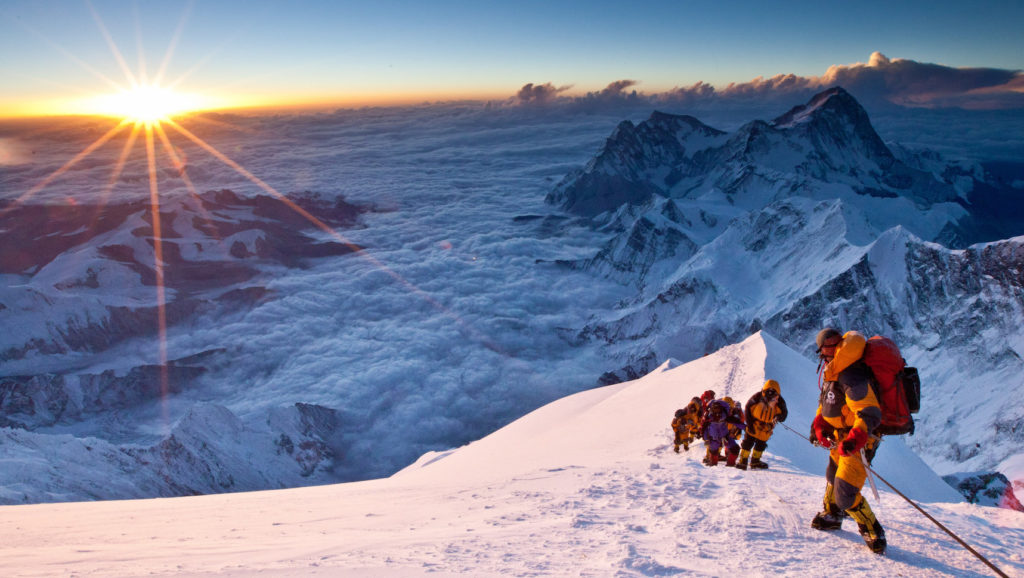
Michael, our lead guide, sets a solid pace for the team and I do my best to continue capturing footage, climbing ahead, locking myself into the safety line, turning around, grabbing shots, etc.
The higher we climb, the more difficult this becomes. As a result, my mind must compensate and carry on. This is the ultimate test of willpower. The moment where my body ceases to function and yet I must carry on stronger than I’ve ever climbed before.
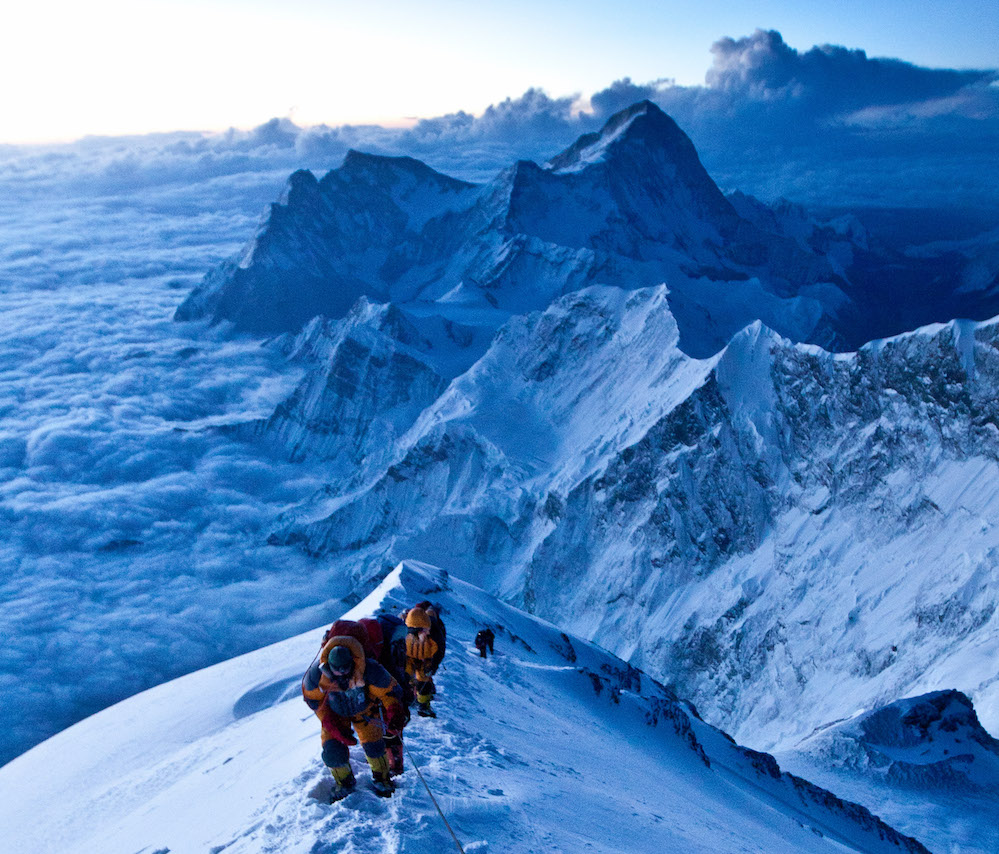
My greatest strength resides not in my body, but in my mind. Tirelessly, I climb with all of my heart. Within 30 minutes of experiencing the beautiful sunrise, I notice a strange shape lying in the snow at the next anchor.
I realize after careful analysis that I am about to come face to face with death.
The deceased man’s down-suit is blue and his body appears to be hanging upside-down. I’m not going to look, I tell myself. The man is dark-skinned with a slight beard. It appears as though he has been there for no more than two days. Emotionally, I know I have to move past him, but as I try, I collapse right next to him. Tears flow down my cheeks and I can feel my eyelids starting to freeze shut. I whisper: I’m sorry for your sister. I’m sorry for your mother. I’m sorry for your father. I’m sorry for your cousin. I’m on my knees next to his dead body and I feel as though I am absorbing the pain of so many who would soon learn of this man’s tragedy. This could be me. This could be any of us. More than ever, I want off this mountain. I pay my respects and I carry on.
The ascent from the fallen climber to the south summit is the most difficult section for me.
I feel dead inside.
I allow myself to live emotionally in the moment before cutting it all off and reminding myself that I too can end up like him if I don’t get it together. So I continue climbing, struggling to pull my weight up the steep, jagged rocks beneath the south summit.
Michael, our lead guide and I agreed on a plan for me to film from the top of the Hillary Step – the famous nine-metre section of rock pioneered 60 years ago by the late Sir Edmund Hillary and his partner Tenzing Norgay. I sit exhausted on the side of the trail waiting for Michael to catch up with the team and he advises me to climb ahead, descend the south summit, swap my oxygen bottle out for a fresh one and get myself into position. I gladly comply.
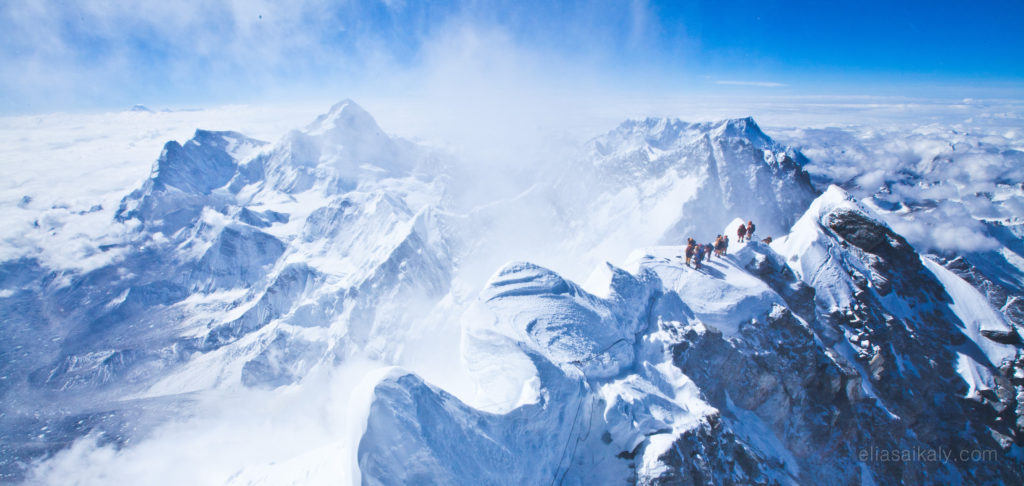
I can feel my body slowly shutting down. The weight of my tripod, two cameras, all of my batteries and oxygen has taken its toll on me. I have been revving at 120% for the past 10 hours and I’m almost out of gas. I am the first to arrive and notice instantly that we have the mountain to ourselves. I gaze ahead and note the sheer beauty of the wind howling and racing across the summit.
The tallest peak on Earth is within sight. I am completely alone making my way toward the Hillary Step.

As I approach the iconic obstacle, I look to my left and note the 2,400-metre drop into the Western CWM. I can actually see camp two from where I am standing. I haul myself up the nine-meter cliff, camera around my neck, oxygen cylinder pumping four litres per minute and I wait for the team to arrive. What a glorious moment to be the only person climbing this iconic obstacle without a single human being around. So often, dozens freeze and turn back and now I am just hanging out on top of the step, waiting to capture the unique shot.
One by one, the climbers make their way towards my lens. First it’s Mohammed, then Raed and then Masoud. The magnitude of the moment sets in. I’m filming these boys making history. I am exposed and my life is entrusted into a single safety line to brace my 2,400-metre potential fall into the Western CWM.
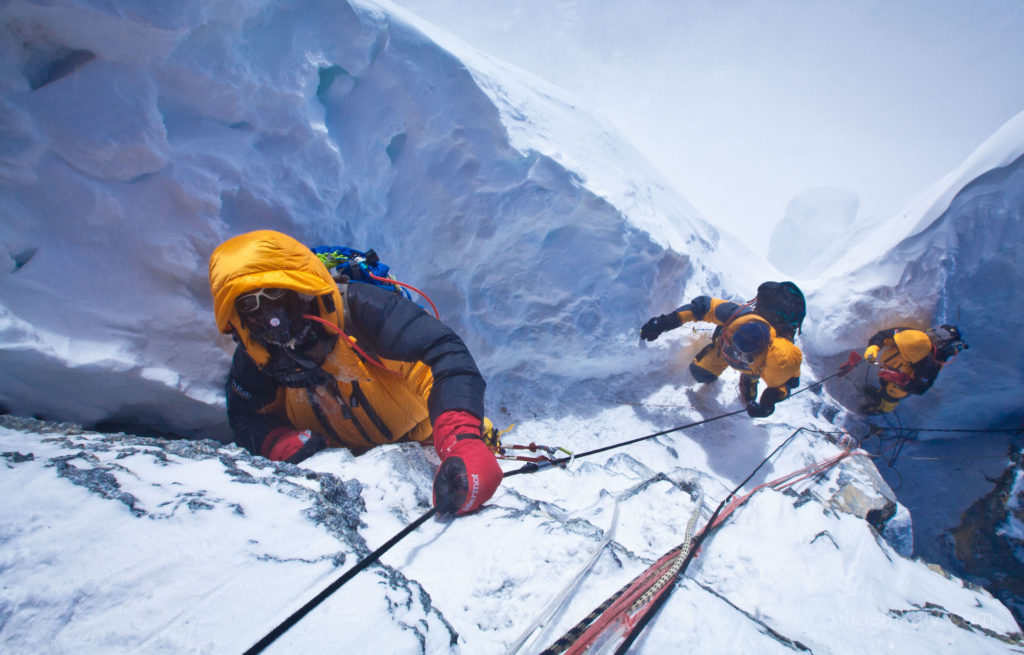
I straddle the rock above the step like a horse and realize I must get ahead of the group in order to capture the team reaching the top. I remove my oxygen mask and ask the team to wait and let me pass at 8,800 metres. I carefully clip and unclip my safety line fourteen times, each time exposing myself to the abyss below, passing every Sherpa and team member in order to get into position for the final shot.
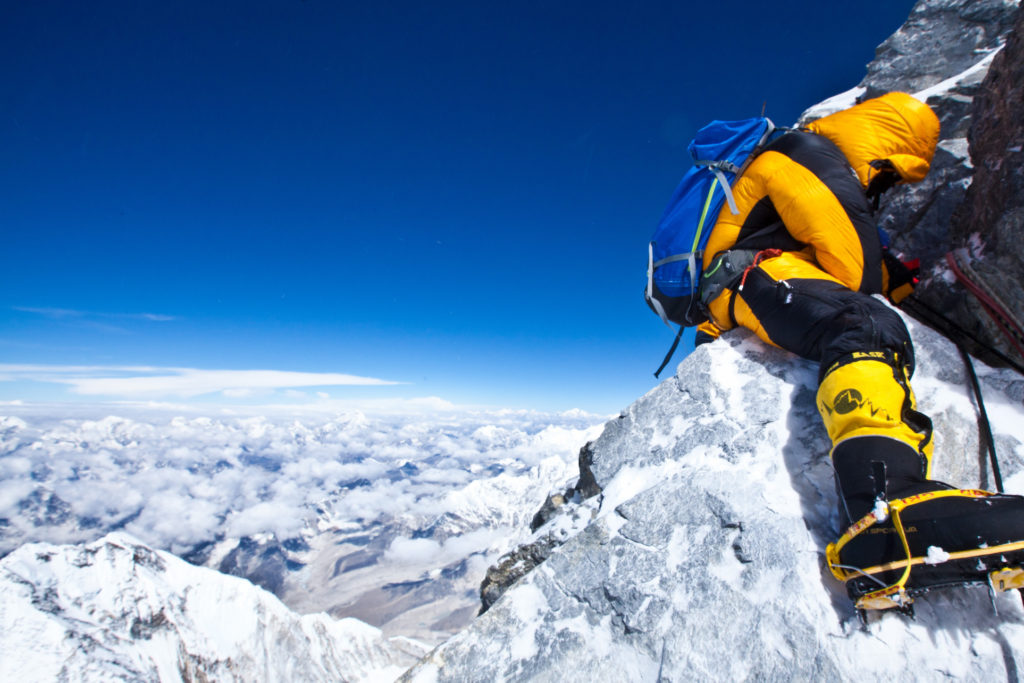
The last ten metres end up becoming the most difficult ten metres of my life. Breath, breath, breath, Step. Step. Step. Breath. Step. Step. Step. Step.
My heart is racing, and my breathing is out of control. It’s all mental at this point and the next thing I know I’m alone on top of the world. I collapse on the absolute highest point, sit on the summit with the world beneath my feet, take out my camera and begin to roll.
Mohammed has just become the first Qatari man to summit Mt. Everest. Raed, the first Palestinian man and Masoud, yet another Iranian to make it to the highest point on the planet. My hands freeze as I record their tears, their emotions and their triumph.
I spend 19 out of 20 minutes on the summit taking photographs of the guys, shooting video all while hoping to get a second to myself to absorb the moment and appreciate where I am once again. After all, it has been three years to the day that I reached the summit of Everest with my dear friend Dr. Sean Egan’s ashes.
Elia, you need to get going down too, says Michael. I need a few minutes, I plead. Before I know it, the others are making their way down the mountain to safety. I pull out my iPhone, sync it to my Delorme InReach and tweet – Top of the world! I then send my partner a message letting her know I am safe and have succeeded in reaching the highest point on Earth. I quickly take a picture of Michael and Pasang and Michael snaps a quick one of me. After-all, I have to prove I was actually here, right?
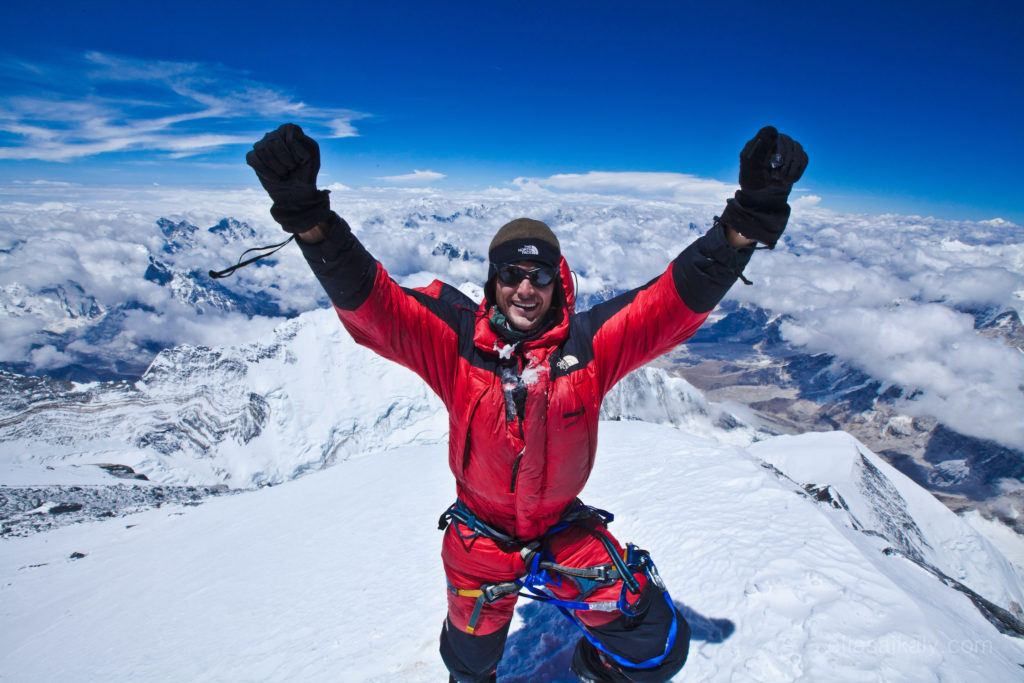
There is a saying in mountaineering coined by Ed Viesters: Getting to the top up is optional and getting down is mandatory. I realize in my moment of elation that I am completely exhausted. We did it!
All I have to do now is climb all the way back down.
——————–
Words and Images by Elia Saikaly ©
Check out more from Elia on his website and see what he is up to on his Instagram.


